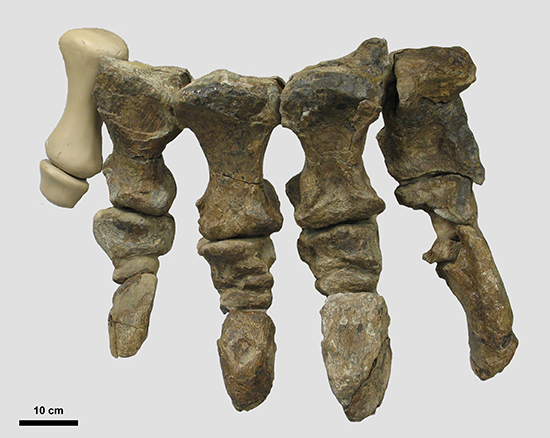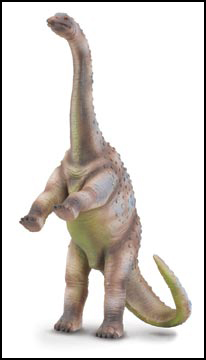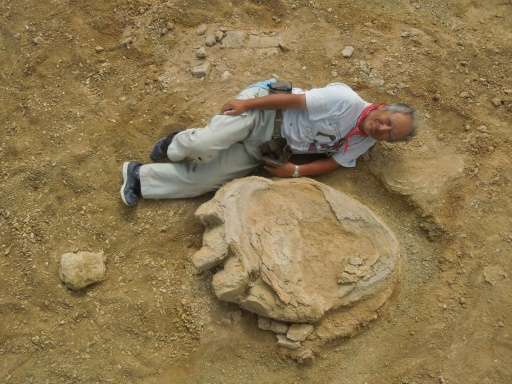Walking with Dinosaurs – How? New Research Finds Answers
Sauropods Had Fleshy Pads on Their Feet
A team of scientists led by researchers from the University of Queensland have concluded that giant, long-necked dinosaurs (Sauropoda), probably walked in a “high-heeled fashion”. Their great weight was supported by a fleshy pad at the base of the foot, effectively cushioning the heel and helping to support their enormous weight. Elephants also have a fleshy pad on their feet, it seems that these two types of terrestrial, giant tetrapods, although not closely related, evolved the same type of soft tissue pad supporting the elevated metatarsus, an example of convergent evolution.
An Anatomical Reconstruction of the Right Hind Foot of a Sauropod (Rhoetosaurus brownei)

Picture credit: Jay P. Nair and Andréas Jannel (University of Queensland)
Sauropod Locomotion – The Biomechanics
How the sauropod foot worked is very poorly understood. This is partly because there are not that many complete foot fossils to study (manus and pes in these quadrupeds), especially amongst early members of the group and there is no living equivalent of these long-necked giants around today, to provide scientists with anatomical comparisons. The researchers from the University of Queensland in collaboration with colleagues from Monash University (Victoria), examined the foot and toe bones of Rhoetosaurus brownei in a bid to plot the biomechanics of sauropod locomotion.
At around twenty tonnes and with a body length in excess of fourteen metres, Rhoetosaurus was a very sizeable animal, but certainly not the biggest of the Sauropoda. However, it is known from eastern Australia so its fossils were easy to access for the researchers and it is the earliest representative of sauropods known from Australia. In fact, according to the press release from the University of Queensland, it is the only named Australian sauropod that dates from the Jurassic. Conveniently, it is the only one from the Gondwanan Middle Jurassic that preserves an articulated foot.
A Model of Rhoetosaurus (R. brownei)

Three-dimensional Modelling of a Dinosaur’s Foot
The scientists carefully analysed the foot bones and compared them to the foot bones of an African elephant (Loxodonta). Lead author of the research, PhD student Andréas Jannel (University of Queensland), explained:
“Looking at the bones of the foot, it was clear that Rhoetosaurus walked with an elevated heel, raising the question: how was its foot able to support the immense mass of this animal, up to 40 tonnes? Our research suggests that even though Rhoetosaurus stood on its tiptoes, the heel was cushioned by a fleshy pad. We see a similar thing in elephant feet, but this dinosaur was at least five times as heavy as an elephant, so the forces involved are much greater.”
The researchers used physical models and computer simulations to map the posture and the range of motion of the foot bones. The results generated permitted the team to model all the foot bone postures and from this it was deduced that some of these movements would have been restricted by soft tissue in life, but this soft tissue would have helped to support the animal’s great weight.
Studying the Sauropod Pes
The team concluded that the in‐life plantar surface of the sauropod pes is inferred to extend caudally from the digits, with a soft tissue pad supporting the elevated foot bones, in essence, these terrestrial giants walked in a “high-heeled fashion”. Furthermore, the plantar pad is inferred to play a role in the reduction of biomechanical stresses, and to aid in support and locomotion.
A foot pad may have been a key biomechanical innovation in early sauropods, ultimately resulting in a functionally plantigrade foot, which may have arisen during the Early to Middle Jurassic. Although, these dinosaurs, like all other dinosaurs had a digitigrade or semi-digitigrade stance, the soft tissue pad changed their feet morphologically, so, these dinosaurs had a more plantigrade stance (not just walking on their toes).
This research into the locomotion of the biggest land vertebrates that ever lived has provided some intriguing insights, but the authors of the scientific paper admit that further mechanical studies are ultimately required to permit a more complete understanding of how these giants moved about.
Studies of Sauropod Tracks and Trackways Lend Support to Idea that these Animals Walked on Pads of Soft Tissue

Picture credit: Okayama University of Science
The scientific paper: “Keep your Feet on the Ground”: Simulated Range of Motion and Hind Foot Posture of the Middle Jurassic Sauropod Rhoetosaurus brownei and its Implications for Sauropod Biology by Andréas Jannel, Jay P. Nair, Olga Panagiotopoulou, Anthony Romilio and Steven W. Salisbury published in the Journal of Morphology.
Visit the Everything Dinosaur website: Everything Dinosaur.

